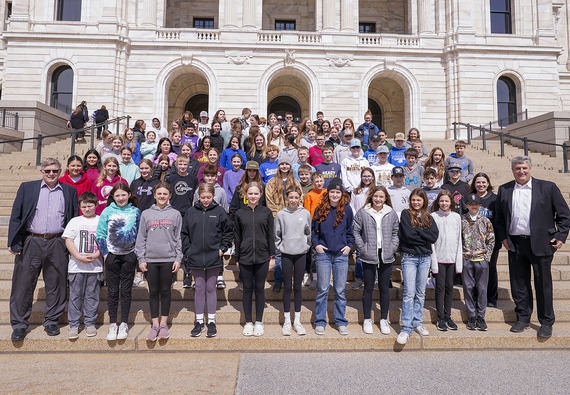
Enjoyed meeting with sixth- and seventh-grade students from BBE during their recent trip to the Capitol. Hope you enjoyed your visit!
Dear Neighbor,
Avian influenza has resurfaced as a topic of discussion at the Capitol and among people in the ag industry after the Minnesota Board of Animal Health recently announced that highly pathogenic avian influenza (HPAI) was detected in baby goats in Stevens County.
Minnesota’s poultry flock has suffered setbacks from the bird flu, but this latest HPAI detection was the first in U.S. livestock. Since then, HPAI cases have emerged in multiple states, including reports of infected dairy cows. The good news, so far, is the livestock animals are getting sick but not dying.
The House ag committee addressed this issue during a meeting this week and we heard from the state veterinarian. Many questions remain. We are not sure how long HPAI infections have been occurring, and don’t know how much our increased testing is playing a factor.
For now, the key takeaways are state officials are on top of this and will continue monitoring the situation, and citizens should continue executing good biosecurity practices on all livestock farms in our state.
Click here for more on this issue.
In other news, the House and Senate majorities and the governor recently announced they have reached an agreement to spend at least $512.5 million more in 2024-25 – even with a shortfall projected for the next biennium.
This is in addition to the budget they passed last year, which spent the $18 billion surplus and raised taxes by $10 billion to increase state spending by 40 percent.
This is very concerning because we should be making more careful budget choices. Additional spending this year could mean a bigger shortfall next year while increasing state spending at an even more unsustainable rate.
Another point of concern is that, despite half a billion dollars in new state spending, the new proposal fails to fully fund the critical needs of our emergency medical services across the state, providing $16 million for rural EMS – far short of the actual need. Ambulance providers are struggling under the current “fee-for-service” model, which has left rural areas of the state with decreasing access to ambulances and other EMS options. I will continue working with fellow legislators to advocate for more aid to licensed ambulance service providers in Greater Minnesota because public safety is a chief responsibility of our state.
Watch for more news from the Capitol soon. We are entering the final full six weeks of the 2024 session and it will be interesting to see what unfolds between now and our May 20 date for adjournment.
Sincerely,
Paul